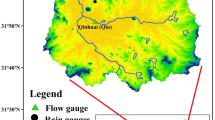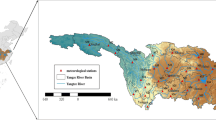Abstract
Meteorological droughts can affect large areas and may have serious environmental, social and economic impacts. These impacts depend on the severity, duration, and spatial extent of the precipitation deficit and the socioeconomic vulnerability of the affected regions. This paper examines the spatiotemporal variation of meteorological droughts in the Haihe River basin. Meteorological droughts events were diagnosed using daily meteorological data from 44 stations by calculating a comprehensive drought index (CI) for the period 1961–2011. Based on the daily CI values of each station over the past 50 years, the drought processes at each station were confirmed, and the severity, duration and frequency of each meteorological drought event were computed and analyzed. The results suggest the following conclusions: (1) the use of the CI index can effectively trace the development of drought and can also identify the duration and severity of each drought event; (2) the average drought duration was 57–85 days in each region of the Haihe River basin, and the region with the highest average values of drought duration and drought severity was Bohai Bay; (3) drought occurred more than 48 times over the study period, which is more than 0.95 times per year over the 50 years studied. The average frequencies of non-drought days, severe drought days and extreme drought days over the study period were 51.2, 3.2 and 0.4 %, respectively. Severe drought events mainly occurred in the south branch of the Hai River, and extreme drought events mainly occurred in the Shandong Peninsula and Bohai Bay; (4) the annual precipitation and potential evapotranspiration of the Haihe River basin show decreasing trends over the past 50 years. The frequency of severe drought and extreme drought events has increased in the past 20 years than during the period 1961–1990. The results of this study may serve as a reference point for decision regarding basin water resources management, ecological recovery and drought hazard vulnerability analysis.








Similar content being viewed by others
References
Abramowitz M, Stegun IA (1965) Handbook of mathematical functions with formulas, graph, and mathematical tables. Appl Math Ser 55:1046
Allen RG, Pereira LS, Raes D, Smith M (1998) Crop evapotranspiration-Guidelines for computing crop water requirements-FAO irrigation and drainage paper 56. FAO Rome 300:6541
Alley WM (1984) The palmer drought severity index: limitations and assumptions. J Climate Appl Meteorol 23(7):1100–1109
Bacanli UG, Dikbas F, Baran T (2011) Meteorological drought analysis case study: Central Anatolia. Desalin Water Treat 26(1–3):14–23
Barua S, Ng A, Perera B (2010) Comparative evaluation of drought indexes: case study on the Yarra River catchment in Australia. J Water Resour Plan Manage 137(2):215–226
Burke EJ, Brown SJ (2010) Regional drought over the UK and changes in the future. J Hydrol 394(3–4):471–485
Cai J, Liu Y, Lei T, Pereira LS (2007) Estimating reference evapotranspiration with the FAO penman-monteith equation using daily weather forecast messages. Agric For Meteorol 145(1):22–35
Chen ZH, Yang GF (2012) Analysis of drought hazards in North China: distribution and interpretation. Nat Hazard 65(1):279–294
Chu JT et al (2010) Spatial and temporal variability of daily precipitation in Haihe River basin, 1958–2007. J Geogr Sci 20(2):13
Dai A, Trenberth KE, Karl TR (1998) Global variations in droughts and wet spells: 1900–1995. Geophys Res Lett 25(17):3367–3370
Dash BK, Rafiuddin M, Khanam F, Islam MN (2012) Characteristics of meteorological drought in Bangladesh. Nat Hazard 64(2):1461–1474
Edwards DC (1997) Characteristics of 20th Century drought in the United States at multiple time scales (No. AFIT-97-051). Air Force Institute of Technology, Wright-Patterson Air Force Base, Ohio
Guttman NB (1998) Comparing the palmer drought index and the standardized precipitation index 1. JAWRA J Am Water Resour Assoc 34(1):113–121
Hallack-Alegria M, Watkins DW, Donald AW (2007) Annual and warm season drought intensity-duration-frequency analysis for Sonora Mexico. J Clim 20(9):1897–1909
Heim J, Richard R (2002) A review of twentieth-century drought indices used in the United States. Bull Am Meteorol Soc 83(8):1149–1165
Jin JL et al (2012) Risk evaluation of China’s natural disaster systems: an approach based on triangular fuzzy numbers and stochastic simulation. Nat Hazard 62(1):129–139
Kim T-W, Valdés JB, Aparicio J (2002) Frequency and spatial characteristics of droughts in the Conchos River Basin Mexico. Water Int 27(3):420–430
Lloyd-Hughes B, Saunders MA (2002) A drought climatology for Europe. Int J Climatol 22(13):1571–1592
McKee TB, Doesken NJ, Kleist J (1993) The relationship of drought frequency and duration to time scales, proceedings of the 8th conference on applied climatology. American Meteorological Society Boston, MA, 179–183
Mishra AK, Singh VP (2009) Analysis of drought severity‐area‐frequency curves using a general circulation model and scenario uncertainty. J Geophys Res Atmos (1984–2012), 114(D6)
Mishra AK, Singh VP (2010) A review of drought concepts. J Hydrol 391(1–2):202–216
Mishra AK, Singh VP (2011) Drought modeling: a review. J Hydrol 403(1–2):157–175
Moradi HR, Rajabi M, Faragzadeh M (2011) Investigation of meteorological drought characteristics in Fars province Iran. Catena 84(1–2):35–46
Morid S, Smakhtin V, Moghaddasi M (2006) Comparison of seven meteorological indices for drought monitoring in Iran. Int J Climatol 26(7):971–985
Nandintsetseg B, Shinoda M (2012) Assessment of drought frequency, duration, and severity and its impact on pasture production in Mongolia. Nat Hazard 66(2):995–1008
Olukayode Oladipo E (1985) A comparative performance analysis of three meteorological drought indices. J Climatol 5(6):655–664
Pradhan S, Sehgal VK, Das DK, Singh R (2011) Analysis of meteorological drought at New Delhi using SPI. J Agrometeorol 13(1):68–71
Quiring SM, Ganesh S (2010) Evaluating the utility of the vegetation condition index (VCI) for monitoring meteorological drought in Texas. Agric For Meteorol 150(3):330–339
Shahid S, Behrawan H (2008) Drought risk assessment in the western part of Bangladesh. Nat Hazard 46(3):391–413
Wilhite DA, Glantz MH (1985) Understanding: the drought phenomenon: the role of definitions. Water Int 10(3):111–120
Wu H, Hayes MJ, Weiss A, Hu Q (2001) An evaluation of the standardized precipitation index, the china-z index and the statistical z-score. Int J Climatol 21(6):745–758
Xiao L (2003) Disaster of drought and waterlogging in Beijing after liberation. Beijing city planning and construction review (04): 111–113
Yan D-H, Yuan Z, Yang Z-Y, Wang Y (2013) Spatial and temporal changes in drought since 1961 in Haihe River basin. Adv Water Sci 24(1):8
Yang XH et al (2009) Chaotic Bayesian method based on multiple criteria decision making (MCDM) for forecasting nonlinear hydrological time series. Int J Nonlinear Sci Numer Simul 10(11–12):1595–1610
Yang XH et al (2011) Nonlinear optimization set pair analysis model (NOSPAM) for assessing water resource renewability. Nonlinear Processes Geophys 18(5):599–607
Zhai L, Feng Q (2008) Spatial and temporal pattern of precipitation and drought in Gansu Province Northwest China. Nat Hazard 49(1):1–24
Zhang TF, Zhang B, Wang YH (2013) Drought characteristics in the Shiyang river basin during the recent 50 years based on a composite index. Acta Ecologica Sinica 33(3):10
Zhao CH et al (2013) Prediction of drought risk based on the WRF model in Yunnan Province of China. Adv Meteorol 2013(2013):1–9
Acknowledgments
This work was supported by the Funds for Creative Research Groups of China (No. 51121003), the Project of National Basic Research Program of China (No. 2010CB951104) and the Program for Changjiang Scholars and Innovative Research Team in University (No. IRT0809).
Author information
Authors and Affiliations
Corresponding author
Rights and permissions
About this article
Cite this article
He, J., Yang, XH., Li, JQ. et al. Spatiotemporal variation of meteorological droughts based on the daily comprehensive drought index in the Haihe River basin, China. Nat Hazards 75 (Suppl 2), 199–217 (2015). https://doi.org/10.1007/s11069-014-1158-8
Received:
Accepted:
Published:
Issue Date:
DOI: https://doi.org/10.1007/s11069-014-1158-8




